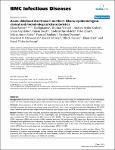Acute childhood diarrhoea in northern Ghana: epidemiological, clinical and microbiological characteristics
Reither, Klaus
Ignatius, Ralf
Weitzel, Thomas
Seidu-Korkor, Andrew
Anyidoho, Louis
Saad, Eiman
Djie-Maletz, Andrea
Ziniel, Peter
Amoo-Sakyi, Felicia
Danikuu, Francis
Danour, Stephen
Otchwemah, Rowland N.
Schreier, Eckart
Bienzle, Ulrich
Stark, Klaus
Mockenhaupt, Frank P.
Background: Acute diarrhoea is a major cause of childhood morbidity and mortality in sub-Saharan Africa. Its microbiological causes and clinico-epidemiological aspects were examined during the dry season 2005/6 in Tamale, urban northern Ghana. Methods: Stool specimens of 243 children with acute diarrhoea and of 124 control children were collected. Patients were clinically examined, and malaria and anaemia were assessed. Rota-, astro-, noro- and adenoviruses were identified by (RT-) PCR assays. Intestinal parasites were diagnosed by microscopy, stool antigen assays and PCR, and bacteria by culturing methods. Results: Watery stools, fever, weakness, and sunken eyes were the most common symptoms in patients (mean age, 10 months). Malaria occurred in 15% and anaemia in 91%; underweight (22%) and wasting (19%) were frequent. Intestinal micro-organisms were isolated from 77% of patients and 53% of controls (P < 0.0001). The most common pathogens in patients were rotavirus (55%), adenovirus (28%) and norovirus (10%); intestinal parasites (5%) and bacteria (5%) were rare. Rotavirus was the only pathogen found significantly more frequently in patients than in controls (odds ratio 7.7; 95%CI, 4.2–14.2), and was associated with young age, fever and watery stools. Patients without an identified cause of diarrhoea more frequently had symptomatic malaria (25%) than those with diagnosed intestinal pathogens (12%, P = 0.02). Conclusion: Rotavirus-infection is the predominant cause of acute childhood diarrhoea in urban northern Ghana. The abundance of putative enteropathogens among controls may indicate prolonged excretion or limited pathogenicity. In this population with a high burden of diarrhoeal and other diseases, sanitation, health education, and rotavirus-vaccination can be expected to have substantial impact on childhood morbidity.
No license information

